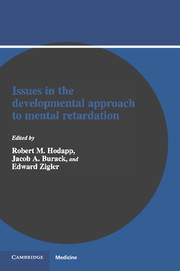Book contents
- Frontmatter
- Contents
- Preface
- Contributors
- Part 1 Developmental theory
- 1 The developmental perspective in the field of mental retardation
- 2 Differentiating mental retardation: The two-group approach and beyond
- 3 One road or many? Issues in the similar-sequence hypothesis
- 4 The similar-structure hypothesis and differential rate of development in mental retardation
- 5 Neo-environmental perspectives on developmental theory
- 6 The role of motivational factors in the functioning of mentally retarded individuals
- Part 2 Applying developmental theory to different types of retarded individuals
- Author index
- Subject index
2 - Differentiating mental retardation: The two-group approach and beyond
from Part 1 - Developmental theory
Published online by Cambridge University Press: 07 September 2010
- Frontmatter
- Contents
- Preface
- Contributors
- Part 1 Developmental theory
- 1 The developmental perspective in the field of mental retardation
- 2 Differentiating mental retardation: The two-group approach and beyond
- 3 One road or many? Issues in the similar-sequence hypothesis
- 4 The similar-structure hypothesis and differential rate of development in mental retardation
- 5 Neo-environmental perspectives on developmental theory
- 6 The role of motivational factors in the functioning of mentally retarded individuals
- Part 2 Applying developmental theory to different types of retarded individuals
- Author index
- Subject index
Summary
For several centuries, medical workers have been interested in differences in etiology among mentally retarded persons. As early as the 17th century, the Swiss physician Felix Platter differentiated between two general types of mentally retarded persons (Scheerenberger, 1983). Individuals of the first type were characterized by simplicity and foolishness that was evident as early as infancy. Individuals of the second type, referred to as endemic cretins, were considered to be dull from before birth and to be suffering from defects of nature (i.e., physical deformity). In the 19th century, John Langdon Down (1887) classified mentally deficient persons (“idiots” and “feeble-minded”) into three etiological groups: congenital, accidental, and developmental. Down also was the first worker to distinguish between mongolism and cretinism. Also at that time, William Wetherspoon Ireland (1877) proposed a 10-category classification of mental retardation that was based primarily on the causes of and the physical differences among the various conditions included in this system. Nine of Ireland's categories were concerned with medical conditions associated with mental retardation; the tenth was “idiocy by deprivation” (Scheerenberger, 1983). These early workers recognized that mentally deficient persons did not comprise a homogeneous population, and could be better understood when the cause of the mental retardation was taken into account.
- Type
- Chapter
- Information
- Publisher: Cambridge University PressPrint publication year: 1990
- 28
- Cited by



